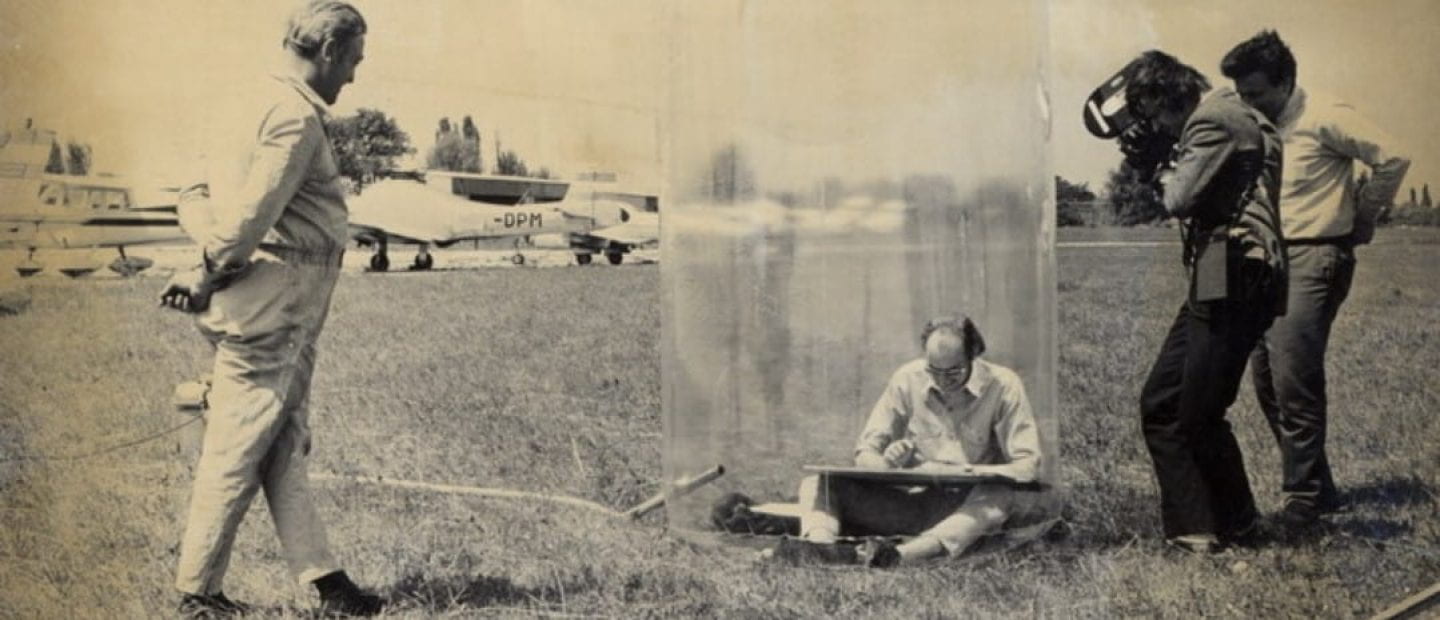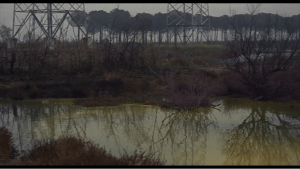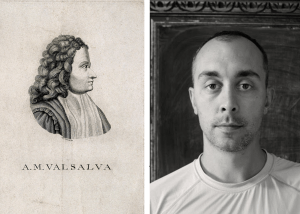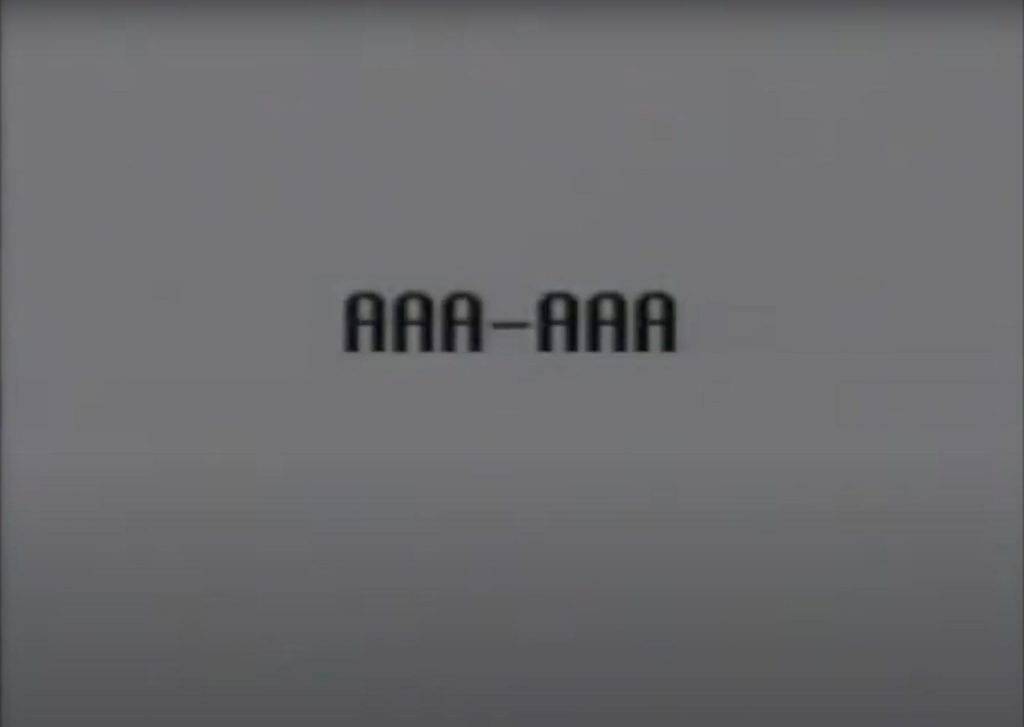Tempest of Industrial Abnature: On John Ruskin’s “Storm-Cloud”
Tempest of Industrial Abnature: On John Ruskin’s “Storm-Cloud”
Today I will be discussing John Ruskin’s late work Storm-Cloud of the Nineteenth Century. The text consists of two lectures delivered at the London Institution in 1884: A first lecture, on the apparition of the so-called “plague cloud,” and a second lecture consisting of notes and expansions from the first. In my presentation, I will briefly summarize Ruskin’s argument; discuss the implications of his methodology; and finally explore the genre conventions by which Ruskin presents his object of study. Ruskin delivered these lectures late in his career, after the failure of his attempts to reverse the ill effects of industrial civilization, and the onset of his struggles with mental illness.
The first Storm Cloud lecture follows a linear narrative. Ruskin begins by defining clouds as meteorological phenomena, identifying the different kinds of clouds that appear in art, literature, and his own experiences, and enumerating diverse cloud formations, as well as the different ways clouds reflect color and diffuse light. He then contrasts his own observations of cloud phenomena with scientific apperception, finding fault with both scientific descriptions as well as the scientific method for selecting and measuring meteorological events. Science has ignored the emergence of the troubling plague-cloud, the titular “storm-cloud of the nineteenth century” which Ruskin has been observing with increasing frequency over the past 50 years. Ruskin goes on to describe this cloud is strikingly animated terms, attributing a kind of malign agency to the heavens that turns out to be a projection of human society all along: for Ruskin, the plague-cloud both expresses, and is caused by, the degeneracy of human morality in the nineteenth century. He inveighs against the blasphemy, avarice, and greed of the new industrial world order that has caused nature herself to turn against humanity. This final section of the lecture proceeds with an increasing elevation of rhetorical force, culminating in Ruskin’s iconic formulation: “Blanched sun— blighted grass— blinded man.” The lecture ends on a plea for a new cheerfulness, honesty, and piety, that might efface the ruinous “signs of the sky,” and return Nature to her former beneficence.
Something of the total structure of Ruskin’s argument is given in the first note to the more fragmentary second lecture:
“To my own mind, and the more distinctly the more I see, know, and feel, the Earth, as prepared for the abode of man, appears distinctly ruled by agencies of health and disease, of which the first may be aided by his industry, prudence, and piety; while the destroying laws are allowed to prevail against him, in the degree which he allows himself in idleness, folly, and vice.”
He analogizes this theological construction of nature onto a renaissance diptych from his private collection:
“The delivery of the Law on Sinai is represented on the left hand (contrary to the Scriptural narrative, but in deeper expression of the benediction of the Sacred Law to all nations,) as in the midst of bright and calm light, the figure of the Deity being supported by luminous and level clouds, and attended by happy angels: while opposite, on the right hand, the worship of the Golden Calf is symbolized by a single decorated pillar, with the calf on its summit, surrounded by the clouds and darkness of a furious storm, issuing from the mouths of fiends.”
This section assembles Ruskin’s worldview into an iconological rebus or emblem, in which the sensible perception of nature corresponds to an underlying moral essence— either the utopia of Natural Theology; or the inferno of divine perdition, which is signally unnatural. Clearly, the plague-cloud of the nineteenth century falls within the gamut of the latter, a view of nature we might also call allegorical. Here we recall Walter Benjamin in The Origin of German Tragic Drama, who defines allegory as “the facies hippocratica of history as petrified, primordial landscape. Everything about history that, from the very beginning has been untimely, sorrowful, unsuccessful, is expressed in a face— or rather, a death’s head.” Ruskin anticipates this definition of allegory by several decades, positing nature as a moral allegory that corresponds to the mournful postlapsarian ruin described by Benjamin; yet which could, by human goodness, be re-enchanted through the light of divine grace.
How does Ruskin’s analytical method relate to his overarching moral framework? Here we might note Ruskin’s constant jibes at scientists: deriding their ignorance, the “frightful inaccuracy” of their language and observations, the inability of the scientific mind to identify objects of inquiry beyond its atrophied epistomology, or account for why these phenomena occur. Science emerges in the text as a foil against which Ruskin can juxtapose his own humanistic, anecdotal, and theologically inflected empiricism. To a modern reader, Ruskin’s presentation of personal observations, diary entries, and letters as evidence against the leading scientists of his day seems slightly pathetic. But Ruskin is not claiming parity between his contributions and scientific thought. Rather, he claims a kind of divine priority for the human sensorium that exceeds the narrowness of unselfconscious science. “The eye and the ear are the creators alike of the ray and the tone; and the conclusion follows logically from the right conception of their living power— ‘He that planted the Ear, shall He not hear? He that formed the Eye, shall not He see?’ “ In this text, Ruskin positions knowledge as co-extensive with the divine origins of the human sensory apparatus, co-opting Victorian theories of differential optical perception and sensory variation into a universalizing moral frame. Hence his praise for Plato’s human-centered optics as “a moral Science of Light [..] more important to you than all the physical laws ever learned by vitreous revelation.” Ruskin’s invocation of Plato anchors his sacralization of unalloyed human perception within a Natural-Theological cosmology:
“The ‘Fiat lux’ of Creation is therefore, in the deep sense, ‘fiat anima,’ and is as much, when you understand it, the ordering of Intelligence as the ordering of Vision. It is the appointment of change of what had been else only a mechanical influence of things unseen to things unseeing— from Stars, that did not shine, to Earth, that did not perceive,— the change, I say, of that blind vibration into the glory of the Sun and Moon for human eyes.”
It is important to note the class dimensions of Ruskin’s critique. One of the letters by Robert Leslie adduced in the second lecture identifies clearly that the “way in which the recent celestial phenomena seem to have taken the whole body of scientific observers by surprise” comes at the expense of “a variety of common folk, like sailors, farmers, and fishermen” to whom the plague winds have “long been a source of perplexity.” Leslie remarks “to such people, the look of the weather, and what comes of that look, is of far more consequence that the exact amount of ozone or the depth nor width of a band of the spectrum.” Here Leslie faults the scientists for the belatedness of their disciplinary knowledge, which lags behind the observations and needs of ordinary people. This anxious passage betrays Ruskin’s own displacement within the shifting of intellectual culture in the late nineteenth century, from a patristic model in which classically educated men of letters could theorize expansively upon natural history, moral philosophy, and human culture; to one in which the natural and human sciences enclosed the formerly unified objects of the universalizing intellect into discrete specialist fields— all while undermining the very notions of “human,” “nature,” and “world” upon which this subjectivity had formerly depended. Ruskin’s valorization of a divinely-ordained, demotic empiricism works to secure a place for both Ruskin himself, as well as the values and knowledges of the “common folk” he is championing, during a profoundly disorienting time.
This existential instability, precipitated by the Darwinian theory of natural selection, thermodynamic conceptions of entropy and heat death, and the geological discovery of deep time, animates Ruskin’s strenuous moral condemnation. He describes the prevailing episteme of nineteenth century scientism as multiply blasphemous: “ ‘Harmful speaking’— not against God only, but against man, and against all the good works and purposes of Nature.” Ruskin sarcastically remarks “the deliberate blasphemy of science, the assertion of its own virtue and dignity against the always implied, and often asserted, vileness of all men and— Gods,— heretofore, is the most wonderful phenomenon.” We must note that Ruskin includes “Mr. Adam Smith, Mr. John Stuart Mill, and other such political economists” among the recipients of his jeremiad, extending the romantic critique of science to a socialist critique of liberalism and laissez-faire political economy. In terms that prefigure the later nineteenth century discourse on degeneration, Ruskin contends:
“The universal instinct of blasphemy in the modern vulgar scientific mind is above all manifested in its love of what is ugly, and natural inthrallment by the abominable;— so that it is ten to one if, in the description of a new bird, you learn much more of it than the enumerated species of vermin that stick to its feathers; and in the natural history museum of Oxford, humanity has been hitherto taught, not by portraits of great men, but by the skulls of cretins.”
Divine damnation, destabilizing narratives of corruption and degeneracy, the constant threat of human regression: this is the constellation through which the Gothic reemerged in the late nineteenth century to articulate anxieties about evolution, morality, and the uncertain future of European modernity. It is thus unsurprising that Ruskin depicts nineteenth century nature in Gothic terms, using imagery that overlaps with that of Shelley, Stoker, Stevenson, and Wilde, to describe an entire life-world gone monstrous. Ruskin stretches his imaginative powers in his evocation of the plague-cloud: it is “malignant… attaching its own qualities of bitterness and malice.” He writes of its “expression of anger as well as of fear […] panic-struck, and feverish; and its sound is a hiss” collapsing a scene from Faust into “the rage, the decrepitude, and the very trembling of the plague-wind.” Prefiguring H.G. Wells, he describes the ruination of his garden: “diabolic clouds over everything: and looking over my kitchen garden yesterday, I found it one miserable mass of weeds gone to seed, the roses in the higher garden putrefied into brown sponges, feeling like dead snails, and the half-ripe strawberries all rotten at the stalks.” His descriptions of plague-wind storms express an almost scandalized terror: “deep, high, filthiness of lurid, yet not sublimely lurid, smoke-cloud […] rolling incessantly, like railway luggage trains, quite ghastly in its mockery of them— the air one loathsome mass of sultry and foul fog.” There is almost a rhetoric of sexual violation here: “One lurid gleam of white cumulus in upper lead-blue sky, seen for half a minute through the sulphurous chimney-pot vomit of blackguardly cloud beneath, where its rags were thinnest.”
Yet most haunting is Ruskin’s evocation of the spectrality of the plague cloud: “it looks more to me as if it were made of dead men’s souls— such of them as are not gone yet where they have to go, and may be flitting hither and thither, doubting, themselves, of the fittest place for them.” This passage combines a series of interrelated images in nineteenth century writing, of the bodies and souls of the working poor as spectral (“the workmen […] would fain lie down and quietly die out of the world that needed them not, but felt as if they could never rest in their graves for the clinging of the beloved and helpless they would leave behind…”); particulate (“Their fathers ground our fathers to the very dust; ground us to powder!”); physically dispersed into the machinery of their exploitation (“I demand, therefore, a working day of normal length, and I demand it without any appeal to your heart […] but the thing you represent face to face with me has no heart in its breast. That which seems to throb there is my own heart-beating.”); and commemorated by divine nature in lieu of human custom:
They think a murderer’s heart would taint
Each simple seed they sow
It is not true! God’s kindly earth
Is kindlier than men know,
And the red rose would but blow more red,
The white rose whiter blow.
Out of his mouth a red red rose!
Out of his heart a white!
Such gothicization of nature has been theorized by Jesse Oak Taylor as “the abnatural.” Drawing on Kelly Hurley’s conception of the Gothic “Abhuman,” Taylor writes: “the abnatural ecology of the fin de siecle Gothic stages the precariousness of bodies, organisms, and habitats in the flux of Hurley’s ‘morphic variability’ produced by exposure to environmental disturbance or pollution: objects, animals, acts, substances, that appear to violate the laws of nature take on forms of agency ordinarily accorded only to the human subject.” While Ruskin’s plague-wind clearly falls within this genealogy, we must remember that the uncanny agency of the diabolical cloud formation is, for him, ultimately an expression of the social depravity that has given rise to it. For if the wind is redolent with the voices of the dead, it was modern society that killed them, and must now contend with the moral toll of its crimes. Ruskin gives a sense of the sweeping, unlocalizable moral atrocity that haunts nineteenth century industrialism in the “Two Boyhoods” section of Modern Painters Volume V, which illuminates the political stakes of this later essay:
“The English death— the European Death of the nineteenth century— was of another range and power […] The life trampled out in the slime of the street, crushed to dust amidst the roaring of the wheel, tossed countlessly away into howling winter wind along five hundred miles of rock-fanged shore. Or, worst of all, rotted down to forgotten graves through years of ignorant patience, and vain seeking for help from man, for hope in God— infirm, imperfect yearning, as of motherless infants starving at dawn; oppressed royalties of captive thought, vague ague-fits of bleak, amazed despair […] Full shone now its awful globe, one pallid charnel-house— a ball strewn bright with human ashes, glaring in poised sway beneath the sun, all blinding-white with death from pole to pole,— death, not of myriads of poor bodies only, but of will, and mercy, and conscience; death, not once inflicted on the flesh, but daily fastening on the spirit…”
This apocalyptic litany inscribes modernity as an abnatural history of human suffering, proceeding not from event to event but as a continuous thought-image of catastrophe echoing across linear time. Ruskin here seems to incarnate Benjamin’s Angel of History: “Where we perceive a chain of events, he sees one single catastrophe which keeps piling wreckage upon wreckage.” The storm blowing from Paradise, that “irresistibly propels him into the future to which his back is turned” is the plague-wind of modern history itself, exceeding Ruskin to reveal itself in new historical images: mustard gas, Auschwitz, the mushroom cloud, the twin towers, the forever wars, the asphyxiated subject of late capitalism, the Anthropocene, and Covid-19. What redemption is left for those in the wake of this ruinous legacy? Ruskin’s plague-cloud casts a long shadow upon us in the Twenty First century, revealing the hideous uniformity in this chain of catastrophes; challenging us to imagine how it— how we— must, of necessity now, be otherwise.
References:
Gaskell, Elizabeth. North and South. Ed. and Intro. Patricia Ingham. Strand, London: Penguin Books. 2003. Print, p. 152. First pub. 1855.
Gere, Charlie. “Ruskin’s haunted nature: art and the spectre of ecological catastrophe.” in The Machine and the Ghost: Technology and Spiritualism in Nineteenth to Twenty First Century Art and Culture. eds. Sas Mays and Neil Matheson. Manchester: Manchester University Press. 2013. Print.
Löwy, Michael and Robert Sayre. Romanticism Against the Tide of Modernity. Trans. Catherine Porter. Durham, NC: Duke University Press. 2001. Print.
Marx, Karl. Capital Vol. 1 excerpted in The Marx-Engels Reader, 2nd Ed. Ed. Robert C. Tucker. Trans. Samuel Moore and Edward Aveling. New York, NY: W.W. Norton & Company. 1978. Print, p. 364. First pub 1867.
Ruskin, John. Storm Cloud of the Nineteenth Century. Gloucester, UK: Dodo Press. 2009. Digital, p.27.
_________.“The King of the Golden River” in Unto This Last: And Other Writings. Ed. and Intro. Clive Wilmer. London: Penguin Classics. 1985. Print, pp. 45-72.
__________. “The Two Boyhoods” in Unto This Last: And Other Writings. Ed. and Intro. Clive Wilmer. London: Penguin Classics. 1985. Print, pp. 144-154.
Scott, Heidi C.M. “Industrial Souls: Climate Change, Immorality, and Victorian Anticipations of the Good Anthropocene.” Victorian Studies Vol. 60 No. 4. Summer 2018. Web, pp. 588-610.
Taylor, Jesse Oak. The Sky of Our Manufacture: The London Fog in British Fiction from Dickens to Woolf. Charlottesville, VA: University of Virginia Press. 2016. Print.
Teukolsky, Rachel. The Literate Eye: Victorian Art Writing and Modernist Aesthetics. New York, NY: Oxford University Press. 2009. Print.
Wilde, Oscar. “The Ballad of Reading Gaol” in Decadent Poetry from Wilde to Naidu. Strand, London: Penguin Books. 2006. Print, p. 29. First pub. 1898.
Williams, Raymond. Culture & Society: 1750-1950. Garden City NY: Anchor Books. 1960. Print.





Leave a Reply
You must be logged in to post a comment.